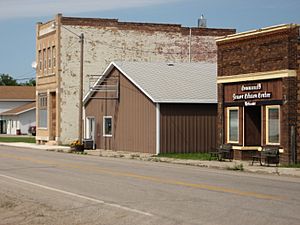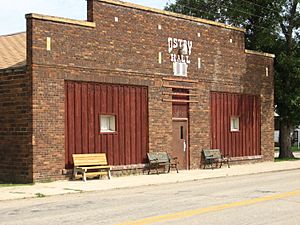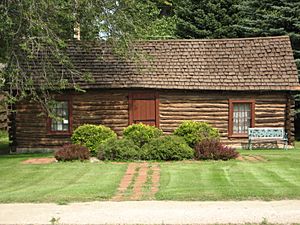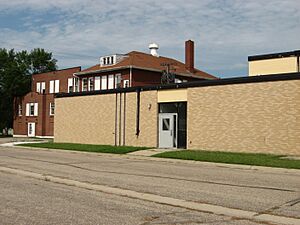Sheyenne, North Dakota facts for kids
Quick facts for kids
Sheyenne, North Dakota
|
|
|---|---|
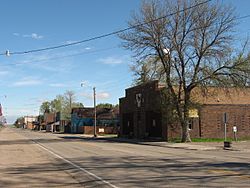
Looking north on U.S. Route 281
|
|
| Motto(s):
Proud To Be A Small Town
|
|
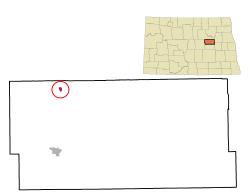
Location of Sheyenne, North Dakota
|
|
| Country | United States |
| State | North Dakota |
| County | Eddy |
| Founded | 1883 |
| Area | |
| • Total | 0.15 sq mi (0.39 km2) |
| • Land | 0.15 sq mi (0.39 km2) |
| • Water | 0.00 sq mi (0.00 km2) |
| Elevation | 1,476 ft (450 m) |
| Population
(2020)
|
|
| • Total | 186 |
| • Estimate
(2022)
|
183 |
| • Density | 1,240.00/sq mi (479.22/km2) |
| Time zone | UTC-6 (Central (CST)) |
| • Summer (DST) | UTC-5 (CDT) |
| ZIP code |
58374
|
| Area code(s) | 701 |
| FIPS code | 38-72580 |
| GNIS feature ID | 1036262 |
Sheyenne is a small city in Eddy County, North Dakota, United States. In 2020, about 186 people lived there. Sheyenne was started in 1883.
You can find a community center and the Log Cabin Museum on Main Street, which is also U.S. Route 281. On the east side of town, there's a park with campsites by Warsing Dam. Sheyenne also has two Lutheran churches: Grace Lutheran and First Lutheran.
Contents
Sheyenne's Story: A Look Back
The name "Sheyenne" comes from the nearby Sheyenne River. This river was named after the Cheyenne Native American tribe. Early explorers misspelled the name, changing the "C" to an "S".
Long ago, huge groups of bison lived on the prairies around Sheyenne. The Sioux tribe was the last Native American group to move into this area. The first white settlers arrived thanks to the Northern Pacific Railroad Company.
The first mention of Sheyenne was in a newspaper called Normadden, from Grand Forks, North Dakota. This Norwegian paper talked about building a section house in 1885. It also mentioned setting up six tents to create a town and a train station. The main train tracks were laid on November 28, 1884. Trains started running to Sheyenne on August 6, 1885.
Clarence E. Bennett first owned the main town area of Sheyenne in 1885. Later, J. W. Richter took over and officially set up the town in 1892. The first crops grown were common vegetables and a lot of wheat. People got meat by hunting on the plains or fishing in the Sheyenne River.
People came to Sheyenne from all over the United States and Europe. Most European settlers were from Scandinavia and Germany. Businesses grew because of the railroad workers and farmers.
The Great Fire of 1894
On December 7, 1894, around 4:30 AM, a fire started in the George Williams Livery Barn. It quickly spread to other businesses on Main Street. Williams' billiard room and soft drink shop burned next. The fire then reached the Westerlund Hotel and the Hugh Peoples General Store.
The post office also caught fire. Luckily, N.U. Hanson saved all the mail inside. Investigators believed the fire was set on purpose. George Williams had closed and locked his stables at 2:00 AM. But when firefighters arrived, the door was open. They later found that the fire began in an unused horse stall. After the fire, the business owners rebuilt their shops and kept serving the Sheyenne area.
Sheyenne was also home to C.G. Hayes, a farmer who lived south of town. Hayes became a soldier and was stationed at Fort Totten. He worked as a scout during the Indian Wars in the Northwest. Later, he served with the Seventh Cavalry. He was one of the messengers who asked for help after The Battle of the Little Bighorn.
In 1897, Sheyenne started its first newspaper, The Sheyenne Star.
Sheyenne in the 1900s
More settlers and immigrants kept coming to the area. They arrived by boxcar, train, cars, and wagons. Sheyenne had many businesses, including department stores, meat markets, and stables. There was a train station, a blacksmith shop, a feed mill, and land companies.
Sheyenne also had several elevators to store local goods. There was a Ford car dealership, many service stations, pharmacies, and cafes. The town had a hotel, a public bath, and a lumberyard. A cream station, an opera house, and a variety store also existed at different times. Many banks opened and closed, including the Farmers' State Bank.
Creamery Day Celebration 1913
The opening of Sheyenne's creamery was a huge event. It happened on June 28, 1913, and over 2,000 people came to celebrate! The day started with a parade that went for 22 blocks. It included the Fort Totten Indian Band, the Boy Scouts, and many floats from local businesses.
The parade ended at the creamery. Everyone got free ice cream and buttermilk. More than 1,900 ice cream cones were given out! The main part of the day was when Professor G.F. Martin from North Dakota Agricultural College (now North Dakota State University) spoke. He talked about how important dairy farming was. After that, a baseball game was played between Sheyenne and New Rockford. At 9:00 PM, a big dance was held at the opera house.
From 1914 to Today
Sheyenne continued to grow through World War I and the 1918 influenza epidemic. A big challenge came in the 1930s with the Great Depression. The main business, agriculture, was hit very hard. Low crop prices affected Sheyenne's economy.
The WPA helped the town a lot. They created a park on the south side of Sheyenne, which is now owned by the VFW. They also fixed up the town jail. WPA workers built Warsing Dam on the edge of the city.
In the 1940s, many residents fought in World War II. The Sheyenne Star newspaper stopped being published. In 1955, North Dakota's second experimental irrigation farm was planned on Bruce Larson's land. In the late 1950s, there was a problem with high nitrate levels in Sheyenne's wells. The Northern Pacific Railway Company solved this by giving their well to the city.
A big event in the 1960s was the opening of Tastee-Freez. This fast food and ice cream restaurant opened in the building that used to be the city's fire department. The 1970s focused on making the community better. Projects like street paving, tennis courts, townhouses, a museum, and main street improvements were completed. In 1977, Sheyenne won the North Dakota Community Betterment Award for all its hard work.
Sheyenne celebrated its 125th birthday with a demo-derby, BBQ dinner, parade, school reunion, fireworks, and a children's theater show by S.T.A.R.S.
Sheyenne's Location and Landscape
Sheyenne is located in the Drift Prairie region of North Dakota. This area has rolling hills and many small wetlands called sloughs. The main river near Sheyenne is the Sheyenne River. Warsing Dam, which is man-made, is a popular spot for outdoor fun near the city.
The area is also part of the Devil's Lake Basin region. Devil's Lake is the largest natural body of water in North Dakota. South of Sheyenne is the Laurentian Divide. This divide separates the rivers that flow into the Arctic Ocean from those that flow into the Atlantic Ocean.
Sheyenne's Weather
Sheyenne has an extreme Continental climate. This means it has big temperature changes and four clear seasons. Because it's in the middle of North America and the Upper Midwest, it has unique upper air patterns that change a lot from season to season.
Sheyenne's Population
| Historical population | |||
|---|---|---|---|
| Census | Pop. | %± | |
| 1930 | 417 | — | |
| 1940 | 431 | 3.4% | |
| 1950 | 469 | 8.8% | |
| 1960 | 423 | −9.8% | |
| 1970 | 362 | −14.4% | |
| 1980 | 307 | −15.2% | |
| 1990 | 272 | −11.4% | |
| 2000 | 318 | 16.9% | |
| 2010 | 204 | −35.8% | |
| 2020 | 186 | −8.8% | |
| 2022 (est.) | 183 | −10.3% | |
| U.S. Decennial Census 2020 Census |
|||
Population in 2010
In 2010, there were 204 people living in Sheyenne. They lived in 103 households, and 51 of these were families. The city had about 1,275 people per square mile.
Most people (81.4%) were White. There were also African American (1.0%) and Native American (14.7%) residents. A small number were from other races or two or more races. About 1.0% of the population was Hispanic or Latino.
About 11.7% of households had children under 18. Many households (37.9%) were married couples. The average household had 1.98 people, and the average family had 2.73 people.
The average age in Sheyenne was 54.3 years old. About 12.3% of residents were under 18. And 24.5% were 65 years or older. The population was almost evenly split between males (49.5%) and females (50.5%).
Fun Places to Visit in Sheyenne
- Log Cabin Museum is a museum that shows the history of the Sheyenne area. The building was built in 1867 near Fort Totten, North Dakota. It was moved to Sheyenne in the 1970s as part of a community project and later made bigger. You can still see the original wood inside. The museum has many old items, like a barber chair and old Sheyenne Star newspapers. It also has clothes owned by John Aasen, who was one of the tallest actors ever. You can also see Native American artifacts found in the area and a Japanese rifle from World War II.
- Warsing Dam is a man-made dam on the east side of Sheyenne. It's a great place for camping and fishing.
Learning in Sheyenne
Before the first Sheyenne school was built, classes in 1886 were held in a sod house. Soon, a wooden building was built west of the railroad tracks. This first school was later moved and became the office for the Sheyenne Star newspaper.
In 1897, a new two-story schoolhouse was built. The first floor was just for school, but the second floor could be used for meetings and church services. In 1898, school closed for two weeks because of scarlet fever and measles. In 1903, many students left to study in Greenfield Township. In April 1903, school was closed again due to a smallpox outbreak.
In 1908, a new school was built on the east side of Sheyenne. In 1930, an addition was made to this brick building. In the late 1950s, they decided to add on again. While the building was being worked on, the Ostby Hall and Grace Lutheran Church were used as extra classrooms. The project was finished in 1962.
Sheyenne High School was open for 99 years until the spring of 2007, when it closed. Today, most children in and around Sheyenne go to school in nearby New Rockford. This is because Sheyenne is part of the New Rockford-Sheyenne Public School district.
Famous People from Sheyenne
- John Aasen, a silent film actor known as the "Norwegian Boy Giant."
See also
 In Spanish: Sheyenne (Dakota del Norte) para niños
In Spanish: Sheyenne (Dakota del Norte) para niños


